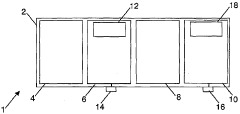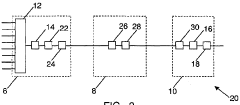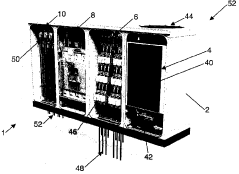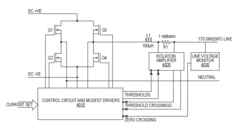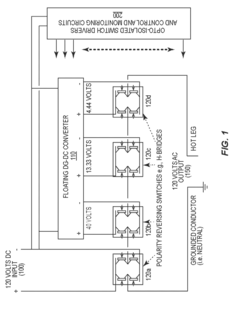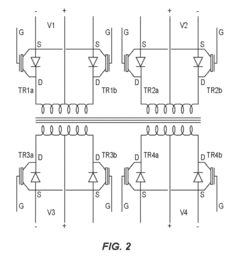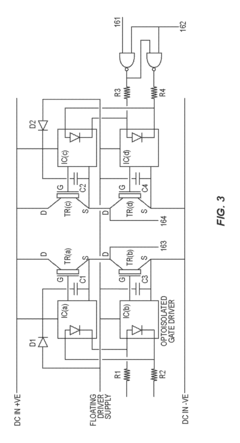Key Components of Modern Solar Inverter Systems
JUL 17, 20259 MIN READ
Generate Your Research Report Instantly with AI Agent
Patsnap Eureka helps you evaluate technical feasibility & market potential.
Solar Inverter Evolution
Solar inverter technology has undergone significant evolution since its inception, driven by the rapid growth of the solar energy industry and the increasing demand for more efficient and reliable power conversion systems. The journey of solar inverter development can be traced through several key stages, each marked by technological advancements and improved performance characteristics.
In the early days of solar energy, basic central inverters were the norm. These large, centralized units were designed to handle the output of entire solar arrays, converting DC power from multiple strings of panels into AC power for grid connection. While effective for their time, these early inverters had limitations in terms of efficiency, flexibility, and system-level optimization.
The next significant step in solar inverter evolution came with the introduction of string inverters. These smaller, more distributed units allowed for greater system design flexibility and improved performance by handling the output of individual strings of solar panels. String inverters offered better monitoring capabilities and reduced the impact of shading or panel mismatch on overall system performance.
As solar technology continued to advance, microinverters emerged as a revolutionary concept. These small inverters, attached to individual solar panels, offered unprecedented levels of granular control and monitoring. Microinverters allowed for panel-level optimization, significantly reducing the impact of shading and panel variations on system output. This technology also enhanced system reliability by eliminating the single point of failure associated with central inverters.
The most recent phase in solar inverter evolution has seen the rise of smart inverters and power optimizers. Smart inverters incorporate advanced communication and control features, allowing for better grid integration and management of solar power systems. These inverters can respond to grid conditions in real-time, adjusting power output and providing ancillary services to support grid stability.
Power optimizers, often used in conjunction with string inverters, represent another significant advancement. These devices, installed at the panel level, optimize DC power before it reaches the inverter, improving overall system efficiency and performance under various environmental conditions.
Throughout this evolution, key trends have emerged, including increased efficiency, improved power density, enhanced communication capabilities, and better integration with energy storage systems. Modern solar inverters now routinely achieve efficiencies above 98%, a significant improvement over early models. The integration of advanced power electronics and digital control systems has also led to more compact and reliable inverter designs.
Looking ahead, the future of solar inverter technology is likely to focus on further integration with smart grid systems, improved energy storage solutions, and enhanced power quality management. As the solar energy landscape continues to evolve, inverter technology will play a crucial role in maximizing the potential of renewable energy sources and supporting the transition to a more sustainable energy future.
In the early days of solar energy, basic central inverters were the norm. These large, centralized units were designed to handle the output of entire solar arrays, converting DC power from multiple strings of panels into AC power for grid connection. While effective for their time, these early inverters had limitations in terms of efficiency, flexibility, and system-level optimization.
The next significant step in solar inverter evolution came with the introduction of string inverters. These smaller, more distributed units allowed for greater system design flexibility and improved performance by handling the output of individual strings of solar panels. String inverters offered better monitoring capabilities and reduced the impact of shading or panel mismatch on overall system performance.
As solar technology continued to advance, microinverters emerged as a revolutionary concept. These small inverters, attached to individual solar panels, offered unprecedented levels of granular control and monitoring. Microinverters allowed for panel-level optimization, significantly reducing the impact of shading and panel variations on system output. This technology also enhanced system reliability by eliminating the single point of failure associated with central inverters.
The most recent phase in solar inverter evolution has seen the rise of smart inverters and power optimizers. Smart inverters incorporate advanced communication and control features, allowing for better grid integration and management of solar power systems. These inverters can respond to grid conditions in real-time, adjusting power output and providing ancillary services to support grid stability.
Power optimizers, often used in conjunction with string inverters, represent another significant advancement. These devices, installed at the panel level, optimize DC power before it reaches the inverter, improving overall system efficiency and performance under various environmental conditions.
Throughout this evolution, key trends have emerged, including increased efficiency, improved power density, enhanced communication capabilities, and better integration with energy storage systems. Modern solar inverters now routinely achieve efficiencies above 98%, a significant improvement over early models. The integration of advanced power electronics and digital control systems has also led to more compact and reliable inverter designs.
Looking ahead, the future of solar inverter technology is likely to focus on further integration with smart grid systems, improved energy storage solutions, and enhanced power quality management. As the solar energy landscape continues to evolve, inverter technology will play a crucial role in maximizing the potential of renewable energy sources and supporting the transition to a more sustainable energy future.
Market Demand Analysis
The global solar inverter market has experienced significant growth in recent years, driven by the increasing adoption of solar energy systems across residential, commercial, and utility-scale applications. This surge in demand is primarily attributed to the declining costs of solar photovoltaic (PV) systems, government incentives, and growing environmental awareness.
In the residential sector, there is a rising trend of homeowners installing rooftop solar panels to reduce electricity bills and achieve energy independence. This has led to a substantial increase in demand for string inverters and microinverters, which are well-suited for small-scale installations. The commercial sector, including businesses, schools, and public buildings, is also witnessing a growing interest in solar energy solutions, driving the demand for three-phase string inverters and central inverters.
Utility-scale solar projects represent a significant portion of the solar inverter market, with large-scale installations requiring high-capacity central inverters or multiple string inverters. The increasing number of solar farms and grid-connected PV systems worldwide has created a robust demand for inverters capable of handling megawatt-scale power outputs.
The market demand for solar inverters is also being shaped by technological advancements and evolving grid requirements. There is a growing need for smart inverters that can provide grid support functions, such as voltage regulation and reactive power control. This trend is driven by utilities seeking to maintain grid stability as the penetration of distributed energy resources increases.
Energy storage integration is another key factor influencing market demand. As battery prices continue to decline, there is an increasing interest in solar-plus-storage systems, particularly in regions with high electricity prices or unreliable grid infrastructure. This has led to a rise in demand for hybrid inverters that can manage both solar PV and battery systems seamlessly.
The global shift towards renewable energy and the implementation of favorable policies in many countries are expected to sustain the growth of the solar inverter market in the coming years. Emerging markets in Asia-Pacific, Latin America, and Africa are showing strong potential for solar energy adoption, which will further drive the demand for inverter systems.
However, the market also faces challenges, such as the need for improved efficiency, reliability, and cost-effectiveness of inverter systems. Manufacturers are focusing on developing next-generation inverters that address these issues while meeting the evolving requirements of modern solar installations. As the solar energy industry continues to mature, the demand for advanced, high-performance inverter systems is expected to grow, presenting significant opportunities for innovation and market expansion in the solar inverter sector.
In the residential sector, there is a rising trend of homeowners installing rooftop solar panels to reduce electricity bills and achieve energy independence. This has led to a substantial increase in demand for string inverters and microinverters, which are well-suited for small-scale installations. The commercial sector, including businesses, schools, and public buildings, is also witnessing a growing interest in solar energy solutions, driving the demand for three-phase string inverters and central inverters.
Utility-scale solar projects represent a significant portion of the solar inverter market, with large-scale installations requiring high-capacity central inverters or multiple string inverters. The increasing number of solar farms and grid-connected PV systems worldwide has created a robust demand for inverters capable of handling megawatt-scale power outputs.
The market demand for solar inverters is also being shaped by technological advancements and evolving grid requirements. There is a growing need for smart inverters that can provide grid support functions, such as voltage regulation and reactive power control. This trend is driven by utilities seeking to maintain grid stability as the penetration of distributed energy resources increases.
Energy storage integration is another key factor influencing market demand. As battery prices continue to decline, there is an increasing interest in solar-plus-storage systems, particularly in regions with high electricity prices or unreliable grid infrastructure. This has led to a rise in demand for hybrid inverters that can manage both solar PV and battery systems seamlessly.
The global shift towards renewable energy and the implementation of favorable policies in many countries are expected to sustain the growth of the solar inverter market in the coming years. Emerging markets in Asia-Pacific, Latin America, and Africa are showing strong potential for solar energy adoption, which will further drive the demand for inverter systems.
However, the market also faces challenges, such as the need for improved efficiency, reliability, and cost-effectiveness of inverter systems. Manufacturers are focusing on developing next-generation inverters that address these issues while meeting the evolving requirements of modern solar installations. As the solar energy industry continues to mature, the demand for advanced, high-performance inverter systems is expected to grow, presenting significant opportunities for innovation and market expansion in the solar inverter sector.
Technical Challenges
Modern solar inverter systems face several significant technical challenges that require ongoing research and innovation to overcome. One of the primary issues is the need for improved efficiency in power conversion. While current inverters can achieve efficiency rates of up to 98%, there is still room for improvement, particularly in reducing energy losses during the DC to AC conversion process. This challenge is compounded by the need to maintain high efficiency across a wide range of input voltages and power levels, as solar panel output can vary significantly based on environmental conditions.
Another critical challenge is the integration of advanced grid support features. As the penetration of solar energy in power grids increases, inverters must be capable of providing grid stability services such as voltage regulation, frequency support, and reactive power control. Developing inverters that can seamlessly transition between grid-connected and islanded modes while maintaining power quality and stability is a complex technical hurdle.
Reliability and longevity of inverter systems present ongoing challenges. Solar installations are expected to operate for 20-25 years, but inverters typically have shorter lifespans. Improving the durability of components, especially capacitors and switching devices, is crucial for extending inverter life and reducing maintenance costs. Additionally, enhancing thermal management systems to cope with varying environmental conditions and high power densities is essential for long-term reliability.
The increasing demand for smart and connected inverter systems introduces challenges in communication and cybersecurity. Inverters must be capable of real-time data exchange with monitoring systems and grid operators, requiring robust communication protocols and interfaces. Ensuring the security of these connected systems against cyber threats is paramount, necessitating advanced encryption and authentication mechanisms.
Size and cost reduction remain persistent challenges in inverter development. As the solar industry strives for greater adoption, there is pressure to minimize the physical footprint of inverters while simultaneously reducing manufacturing costs. This requires innovations in circuit design, component integration, and manufacturing processes.
Lastly, the rapid evolution of solar panel technology, including the rise of bifacial panels and higher voltage systems, demands continuous adaptation of inverter designs. Inverters must be flexible enough to accommodate these technological advancements while maintaining optimal performance and compatibility with existing infrastructure. This ongoing need for adaptability poses a significant challenge for inverter manufacturers and researchers in the field.
Another critical challenge is the integration of advanced grid support features. As the penetration of solar energy in power grids increases, inverters must be capable of providing grid stability services such as voltage regulation, frequency support, and reactive power control. Developing inverters that can seamlessly transition between grid-connected and islanded modes while maintaining power quality and stability is a complex technical hurdle.
Reliability and longevity of inverter systems present ongoing challenges. Solar installations are expected to operate for 20-25 years, but inverters typically have shorter lifespans. Improving the durability of components, especially capacitors and switching devices, is crucial for extending inverter life and reducing maintenance costs. Additionally, enhancing thermal management systems to cope with varying environmental conditions and high power densities is essential for long-term reliability.
The increasing demand for smart and connected inverter systems introduces challenges in communication and cybersecurity. Inverters must be capable of real-time data exchange with monitoring systems and grid operators, requiring robust communication protocols and interfaces. Ensuring the security of these connected systems against cyber threats is paramount, necessitating advanced encryption and authentication mechanisms.
Size and cost reduction remain persistent challenges in inverter development. As the solar industry strives for greater adoption, there is pressure to minimize the physical footprint of inverters while simultaneously reducing manufacturing costs. This requires innovations in circuit design, component integration, and manufacturing processes.
Lastly, the rapid evolution of solar panel technology, including the rise of bifacial panels and higher voltage systems, demands continuous adaptation of inverter designs. Inverters must be flexible enough to accommodate these technological advancements while maintaining optimal performance and compatibility with existing infrastructure. This ongoing need for adaptability poses a significant challenge for inverter manufacturers and researchers in the field.
Current Inverter Solutions
01 Grid-tied solar inverter systems
These systems connect solar panels to the electrical grid, converting DC power from solar panels to AC power for home use and grid feed-in. They often include features like maximum power point tracking (MPPT) and anti-islanding protection for safety and efficiency.- Grid-tied solar inverter systems: These systems connect solar panels to the electrical grid, converting DC power from panels to AC power for home use and grid feed-in. They often include features like maximum power point tracking (MPPT) and anti-islanding protection for safety and efficiency.
- Microinverter technology for solar systems: Microinverters are attached to individual solar panels, converting DC to AC at the panel level. This approach can increase system efficiency, especially in partial shading conditions, and allows for easier system expansion and monitoring of individual panel performance.
- Energy storage integration in solar inverter systems: These systems incorporate battery storage with solar inverters, allowing for energy storage during peak production and use during low production or grid outages. They often include smart energy management features to optimize self-consumption and grid interaction.
- Smart grid-interactive solar inverter systems: Advanced inverter systems with communication capabilities for grid interaction, allowing for dynamic power factor correction, voltage regulation, and demand response. These systems can help stabilize the grid and optimize energy flow between solar installations and the utility network.
- Multi-string inverter configurations for large-scale solar: These systems use multiple input channels to connect several strings of solar panels to a single inverter. This configuration offers flexibility in system design, improved efficiency for large installations, and can accommodate panels with different orientations or specifications.
02 Microinverter technology for solar systems
Microinverters are attached to individual solar panels, converting DC to AC at the panel level. This approach can increase system efficiency, especially in partial shading conditions, and allows for easier system expansion and monitoring of individual panel performance.Expand Specific Solutions03 Energy storage integration in solar inverter systems
These systems incorporate battery storage with solar inverters, allowing for energy storage during peak production and use during low production or grid outages. They often include smart energy management features to optimize self-consumption and grid interaction.Expand Specific Solutions04 Smart grid-interactive solar inverter systems
Advanced inverter systems with communication capabilities for grid interaction, enabling features like remote monitoring, control, and grid support functions. These systems can adjust power output based on grid conditions and participate in demand response programs.Expand Specific Solutions05 Multi-string inverter configurations for large-scale solar installations
These systems use multiple string inputs to a central inverter, allowing for optimization of large solar arrays with different orientations or panel types. They often include features like string-level MPPT and advanced monitoring capabilities for commercial and utility-scale installations.Expand Specific Solutions
Key Industry Players
The market for modern solar inverter systems is in a mature growth phase, characterized by significant technological advancements and increasing global adoption of solar energy. The market size is substantial, driven by the growing demand for renewable energy solutions and government incentives worldwide. Technologically, the field is rapidly evolving, with key players like Enphase Energy, SMA Solar Technology, and SolarEdge Technologies leading innovation in microinverters and power optimizers. Companies such as Huawei Digital Power and Sungrow Power Supply are also making significant strides in smart inverter technology. The competitive landscape is diverse, with established manufacturers and emerging players vying for market share through continuous R&D and strategic partnerships, indicating a high level of technological maturity and market competition.
Enphase Energy, Inc.
Technical Solution: Enphase Energy specializes in microinverter technology for solar systems. Their modern solar inverter systems feature key components such as microinverters, which are attached to individual solar panels. These microinverters convert DC to AC at the panel level, enabling module-level power electronics (MLPE). The system includes the Enphase IQ8 microinverter, which can form a microgrid during a power outage, providing backup power without batteries[1]. The Enphase Envoy communications gateway is another crucial component, managing the microinverters and providing real-time monitoring and analytics[2]. Additionally, Enphase integrates smart battery storage solutions, allowing for energy storage and management, enhancing the overall system efficiency and reliability[3].
Strengths: High efficiency, module-level optimization, and enhanced reliability. Weaknesses: Higher initial cost compared to string inverters, and potential for more points of failure due to multiple components.
SMA Solar Technology AG
Technical Solution: SMA Solar Technology's modern solar inverter systems incorporate several key components designed for high efficiency and reliability. Their central inverters, such as the Sunny Central series, are equipped with advanced power electronics for large-scale solar installations. These systems feature integrated grid management functions, including reactive power control and grid stability support[4]. SMA's string inverters, like the Sunny Tripower series, incorporate multi-string technology and shade management for optimized energy yield. A crucial component is SMA's Smart Connected service, which provides automatic monitoring and fault diagnosis, enhancing system uptime[5]. Additionally, SMA integrates power optimizers in some models, allowing for module-level power electronics when needed, bridging the gap between traditional string inverters and microinverters[6].
Strengths: Wide range of solutions for various scales, advanced grid management features. Weaknesses: Some models may lack the granular control offered by microinverter systems.
Core Inverter Innovations
Solar inverter
PatentActiveIN123CHENP2015A
Innovation
- The solar inverter integrates a cooling module, DC module, inverter module, and AC module side-by-side within a single chassis, improving space efficiency and ease of maintenance.
- The design incorporates a liquid cooling system that pumps coolant around the solar inverter to cool multiple modules, providing more effective cooling for high-power applications.
- The inverter features easily accessible input and output connections on one side of the chassis, with disconnection switches on the opposite side, enhancing installation and maintenance convenience.
Inverter with independent current and voltage controlled outputs
PatentActiveUS20180026550A1
Innovation
- A bimodal DC-to-AC converter design that uses MOSFET switches and bit-density modulation to generate both voltage-controlled and current-controlled AC outputs, allowing for independent operation of grid-tie and standalone modes, reducing transformer reliance and incorporating safety features like ground leakage fault detection.
Grid Integration Standards
Grid integration standards play a crucial role in ensuring the seamless operation of modern solar inverter systems within the broader electrical grid infrastructure. These standards define the technical requirements and operational parameters that solar inverters must meet to maintain grid stability, reliability, and power quality.
One of the primary focuses of grid integration standards is the ability of solar inverters to respond to grid disturbances. This includes requirements for low-voltage ride-through (LVRT) and high-voltage ride-through (HVRT) capabilities, which enable inverters to remain connected and operational during short-term voltage fluctuations. These features help prevent cascading grid failures and maintain overall system stability.
Frequency regulation is another critical aspect addressed by grid integration standards. Solar inverters are required to adjust their output in response to grid frequency deviations, contributing to the overall frequency stability of the power system. This capability is particularly important as the penetration of renewable energy sources increases, potentially leading to greater frequency fluctuations.
Power quality standards are also a key component of grid integration requirements. These standards specify limits for harmonic distortion, voltage flicker, and other power quality parameters that solar inverters must adhere to. By maintaining high power quality, these standards help protect sensitive equipment and ensure the efficient operation of the electrical grid.
Grid integration standards often include provisions for anti-islanding protection. This safety feature ensures that solar inverters disconnect from the grid during power outages, preventing the formation of unintentional islands that could pose risks to utility workers and equipment.
Communication protocols and interoperability standards are increasingly important in modern grid integration requirements. These standards enable solar inverters to communicate with grid operators and other smart grid components, facilitating advanced grid management functions such as remote monitoring, control, and dispatch.
As the penetration of solar energy continues to grow, grid integration standards are evolving to address new challenges. Advanced grid support functions, such as reactive power control and voltage regulation, are becoming more prevalent in modern standards. These capabilities allow solar inverters to actively contribute to grid stability and voltage management.
Compliance with grid integration standards is typically verified through rigorous testing and certification processes. These procedures ensure that solar inverters meet the required performance criteria before they can be connected to the grid, providing assurance to utilities and grid operators.
One of the primary focuses of grid integration standards is the ability of solar inverters to respond to grid disturbances. This includes requirements for low-voltage ride-through (LVRT) and high-voltage ride-through (HVRT) capabilities, which enable inverters to remain connected and operational during short-term voltage fluctuations. These features help prevent cascading grid failures and maintain overall system stability.
Frequency regulation is another critical aspect addressed by grid integration standards. Solar inverters are required to adjust their output in response to grid frequency deviations, contributing to the overall frequency stability of the power system. This capability is particularly important as the penetration of renewable energy sources increases, potentially leading to greater frequency fluctuations.
Power quality standards are also a key component of grid integration requirements. These standards specify limits for harmonic distortion, voltage flicker, and other power quality parameters that solar inverters must adhere to. By maintaining high power quality, these standards help protect sensitive equipment and ensure the efficient operation of the electrical grid.
Grid integration standards often include provisions for anti-islanding protection. This safety feature ensures that solar inverters disconnect from the grid during power outages, preventing the formation of unintentional islands that could pose risks to utility workers and equipment.
Communication protocols and interoperability standards are increasingly important in modern grid integration requirements. These standards enable solar inverters to communicate with grid operators and other smart grid components, facilitating advanced grid management functions such as remote monitoring, control, and dispatch.
As the penetration of solar energy continues to grow, grid integration standards are evolving to address new challenges. Advanced grid support functions, such as reactive power control and voltage regulation, are becoming more prevalent in modern standards. These capabilities allow solar inverters to actively contribute to grid stability and voltage management.
Compliance with grid integration standards is typically verified through rigorous testing and certification processes. These procedures ensure that solar inverters meet the required performance criteria before they can be connected to the grid, providing assurance to utilities and grid operators.
Efficiency Optimization
Efficiency optimization is a critical aspect of modern solar inverter systems, driving continuous improvements in energy conversion and overall system performance. The primary focus of efficiency optimization lies in minimizing power losses throughout the inverter's operation, thereby maximizing the amount of energy delivered to the grid or local loads.
One key area of optimization is the improvement of power semiconductor devices. Advanced materials such as silicon carbide (SiC) and gallium nitride (GaN) are increasingly being utilized in inverter designs. These wide-bandgap semiconductors offer superior switching characteristics, lower on-state resistance, and better thermal performance compared to traditional silicon-based devices. As a result, inverters incorporating these materials can achieve higher switching frequencies, reduced switching losses, and improved overall efficiency.
Another significant aspect of efficiency optimization is the refinement of inverter topologies. Multi-level inverter designs, such as neutral-point-clamped (NPC) and cascaded H-bridge configurations, have gained prominence due to their ability to produce high-quality output waveforms with reduced harmonic distortion. These topologies also allow for lower switching frequencies, which can further reduce losses and improve efficiency.
Advanced control algorithms play a crucial role in optimizing inverter efficiency across various operating conditions. Maximum power point tracking (MPPT) algorithms ensure that the inverter operates at the optimal point on the solar panel's I-V curve, maximizing energy harvest. Additionally, adaptive control strategies that dynamically adjust inverter parameters based on real-time conditions, such as irradiance and temperature, help maintain high efficiency throughout the day.
Thermal management is another critical factor in efficiency optimization. Improved heat dissipation techniques, including advanced cooling systems and thermally conductive materials, help maintain lower operating temperatures for inverter components. This not only enhances efficiency by reducing temperature-related losses but also extends the lifespan of the inverter system.
The integration of energy storage systems with solar inverters has opened new avenues for efficiency optimization. Hybrid inverters that seamlessly manage power flow between solar panels, batteries, and the grid can optimize energy utilization by storing excess solar energy during peak production periods and using it during low-production or high-demand periods. This approach not only improves overall system efficiency but also enhances grid stability and reduces reliance on fossil fuel-based power sources.
One key area of optimization is the improvement of power semiconductor devices. Advanced materials such as silicon carbide (SiC) and gallium nitride (GaN) are increasingly being utilized in inverter designs. These wide-bandgap semiconductors offer superior switching characteristics, lower on-state resistance, and better thermal performance compared to traditional silicon-based devices. As a result, inverters incorporating these materials can achieve higher switching frequencies, reduced switching losses, and improved overall efficiency.
Another significant aspect of efficiency optimization is the refinement of inverter topologies. Multi-level inverter designs, such as neutral-point-clamped (NPC) and cascaded H-bridge configurations, have gained prominence due to their ability to produce high-quality output waveforms with reduced harmonic distortion. These topologies also allow for lower switching frequencies, which can further reduce losses and improve efficiency.
Advanced control algorithms play a crucial role in optimizing inverter efficiency across various operating conditions. Maximum power point tracking (MPPT) algorithms ensure that the inverter operates at the optimal point on the solar panel's I-V curve, maximizing energy harvest. Additionally, adaptive control strategies that dynamically adjust inverter parameters based on real-time conditions, such as irradiance and temperature, help maintain high efficiency throughout the day.
Thermal management is another critical factor in efficiency optimization. Improved heat dissipation techniques, including advanced cooling systems and thermally conductive materials, help maintain lower operating temperatures for inverter components. This not only enhances efficiency by reducing temperature-related losses but also extends the lifespan of the inverter system.
The integration of energy storage systems with solar inverters has opened new avenues for efficiency optimization. Hybrid inverters that seamlessly manage power flow between solar panels, batteries, and the grid can optimize energy utilization by storing excess solar energy during peak production periods and using it during low-production or high-demand periods. This approach not only improves overall system efficiency but also enhances grid stability and reduces reliance on fossil fuel-based power sources.
Unlock deeper insights with Patsnap Eureka Quick Research — get a full tech report to explore trends and direct your research. Try now!
Generate Your Research Report Instantly with AI Agent
Supercharge your innovation with Patsnap Eureka AI Agent Platform!

